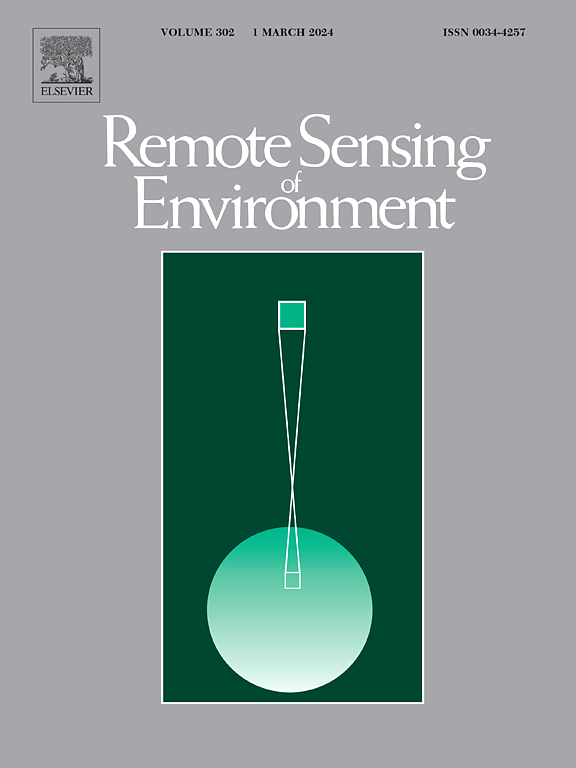GROUNDED EO: Data-driven Sentinel-2 LAI and FAPAR retrieval using Gaussian processes trained with extensive fiducial reference measurements
IF 11.1
1区 地球科学
Q1 ENVIRONMENTAL SCIENCES
引用次数: 0
Abstract
Due to their importance in monitoring and modelling Earth's climate, the Global Climate Observing System (GCOS) designates leaf area index (LAI) and the fraction of absorbed photosynthetically active radiation (FAPAR) as essential climate variables (ECVs). The Simplified Level 2 Biophysical Processor (SL2P) has proven particularly popular for decametric (i.e. 10 m to 100 m) retrieval of these ECVs. Comprehensive validation has shown that due to simplifying assumptions in the underlying radiative transfer models (RTMs), biases persist in SL2P retrievals. To avoid RTM assumptions altogether, an empirical data-driven approach might be considered. Yet, such a strategy has historically been prevented by the limited quantity and quality of available in situ reference measurements, as well as the large number of training samples traditionally required by machine learning regression algorithms. New opportunities are now offered by recently established continental-scale environmental monitoring networks, advances in automated data processing and uncertainty evaluation, and machine learning regression algorithms that require many fewer training samples. The Ground Reference Observations Underlying Novel Decametric Vegetation Data Products from Earth Observation (GROUNDED EO) project was initiated to take advantage of these opportunities. We describe the empirical data-driven LAI and FAPAR retrieval approach adopted within the project, involving i) generation of a database containing over 16,000 fiducial reference measurements covering 81 National Ecological Observatory Network (NEON), Integrated Carbon Observation System (ICOS), and Terrestrial Ecosystem Research Network (TERN) sites between 2013 and 2022, ii) development of an empirical data-driven algorithm for Sentinel-2 LAI and FAPAR retrieval based on Gaussian processes, and iii) evaluation of GROUNDED EO retrievals through intercomparison with the current state-of-the-art in decametric retrieval (i.e. SL2P, and a modified version of SL2P developed by the Canada Centre for Remote Sensing – SL2P-CCRS), as well as validation against unseen fiducial reference measurements. In the majority of cases (and despite not making use of ancillary data such as land cover), the empirical data-driven GROUNDED EO retrievals were subject to reduced bias than those from SL2P and SL2P-CCRS, as well as increased fulfilment of user requirements (i.e. 74% of LAI and 69% of FAPAR retrievals overall). Consequently, the approach has potential to reduce uncertainty in key inputs for climate monitoring and modelling, agricultural and forest management, and biodiversity assessment.
ground EO:数据驱动的Sentinel-2 LAI和FAPAR检索,使用经过广泛基准参考测量训练的高斯过程
全球气候观测系统(GCOS)将叶面积指数(LAI)和光合有效辐射吸收分数(FAPAR)作为基本气候变量(ecv),考虑到它们在地球气候监测和模拟中的重要性。简化的2级生物物理处理器(SL2P)已被证明特别受欢迎,用于十米(即10米至100米)检索这些ecv。综合验证表明,由于基础辐射传输模型(rtm)中的假设简化,在SL2P反演中仍然存在偏差。为了完全避免RTM假设,可以考虑采用经验数据驱动的方法。然而,这种策略历来受到可用的原位参考测量的数量和质量的限制,以及机器学习回归算法传统上所需的大量训练样本的阻碍。最近建立的大陆尺度环境监测网络,自动化数据处理和不确定性评估的进步,以及需要更少训练样本的机器学习回归算法,现在提供了新的机会。利用这些机会,启动了基于地球观测新十尺度植被数据产品的地面参考观测(GROUNDED EO)项目。我们描述了项目中采用的经验数据驱动的LAI和FAPAR检索方法,包括i)在2013年至2022年期间生成包含81个国家生态观测站网络(NEON),综合碳观测系统(ICOS)和陆地生态系统研究网络(TERN)站点的16,000多个基准参考测量值的数据库,ii)开发基于高斯过程的Sentinel-2 LAI和FAPAR检索的经验数据驱动算法。iii)通过与当前最先进的十米制检索(即SL2P和加拿大遥感中心开发的SL2P改进版本- SL2P- ccrs)的相互比较来评估接地EO检索,以及对未见基准参考测量的验证。在大多数情况下(尽管没有使用土地覆盖等辅助数据),经验数据驱动的接地EO检索比SL2P和SL2P- ccrs检索的偏差更小,并且增加了用户需求的满足(即总体上74%的LAI和69%的FAPAR检索)。因此,该方法有可能减少气候监测和建模、农业和森林管理以及生物多样性评估等关键投入的不确定性。
本文章由计算机程序翻译,如有差异,请以英文原文为准。
求助全文
约1分钟内获得全文
求助全文
来源期刊

Remote Sensing of Environment
环境科学-成像科学与照相技术
CiteScore
25.10
自引率
8.90%
发文量
455
审稿时长
53 days
期刊介绍:
Remote Sensing of Environment (RSE) serves the Earth observation community by disseminating results on the theory, science, applications, and technology that contribute to advancing the field of remote sensing. With a thoroughly interdisciplinary approach, RSE encompasses terrestrial, oceanic, and atmospheric sensing.
The journal emphasizes biophysical and quantitative approaches to remote sensing at local to global scales, covering a diverse range of applications and techniques.
RSE serves as a vital platform for the exchange of knowledge and advancements in the dynamic field of remote sensing.
 求助内容:
求助内容: 应助结果提醒方式:
应助结果提醒方式:


